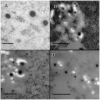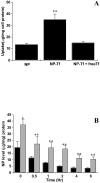Biodegradable nanoparticles for cytosolic delivery of therapeutics
- PMID: 17683826
- PMCID: PMC2002520
- DOI: 10.1016/j.addr.2007.06.003
Biodegradable nanoparticles for cytosolic delivery of therapeutics
Abstract
Many therapeutics require efficient cytosolic delivery either because the receptors for those drugs are located in the cytosol or their site of action is an intracellular organelle that requires transport through the cytosolic compartment. To achieve efficient cytosolic delivery of therapeutics, different nanomaterials have been developed that consider the diverse physicochemical nature of therapeutics (macromolecule to small molecule; water soluble to water insoluble) and various membrane associated and intracellular barriers that these systems need to overcome to efficiently deliver and retain therapeutics in the cytoplasmic compartment. Our interest is in investigating PLGA and PLA-based nanoparticles for intracellular delivery of drugs and genes. The present review discusses the various aspects of our studies and emphasizes the need for understanding of the molecular mechanisms of intracellular trafficking of nanoparticles in order to develop an efficient cytosolic delivery system.
Figures






Similar articles
-
Preparation of DHAQ-loaded mPEG-PLGA-mPEG nanoparticles and evaluation of drug release behaviors in vitro/in vivo.J Mater Sci Mater Med. 2006 Jun;17(6):509-16. doi: 10.1007/s10856-006-8933-3. J Mater Sci Mater Med. 2006. PMID: 16691348
-
Biodegradable microparticles for sustained release of a new GnRH antagonist--part I: Screening commercial PLGA and formulation technologies.Eur J Pharm Biopharm. 2003 Nov;56(3):327-36. doi: 10.1016/s0939-6411(03)00096-1. Eur J Pharm Biopharm. 2003. PMID: 14602174
-
Protein instability in poly(lactic-co-glycolic acid) microparticles.Pharm Res. 2000 Oct;17(10):1159-67. doi: 10.1023/a:1026498209874. Pharm Res. 2000. PMID: 11145219 Review.
-
Sustained cytoplasmic delivery and anti-viral effect of PLGA nanoparticles carrying a nucleic acid-hydrolyzing monoclonal antibody.Pharm Res. 2012 Apr;29(4):932-42. doi: 10.1007/s11095-011-0633-0. Epub 2011 Dec 3. Pharm Res. 2012. PMID: 22139535
-
Biodegradable nanoparticles for drug and gene delivery to cells and tissue.Adv Drug Deliv Rev. 2003 Feb 24;55(3):329-47. doi: 10.1016/s0169-409x(02)00228-4. Adv Drug Deliv Rev. 2003. PMID: 12628320 Review.
Cited by
-
Cationic additives in nanosystems activate cytotoxicity and inflammatory response of human neutrophils: lipid nanoparticles versus polymeric nanoparticles.Int J Nanomedicine. 2015 Jan 7;10:371-85. doi: 10.2147/IJN.S73017. eCollection 2015. Int J Nanomedicine. 2015. PMID: 25609950 Free PMC article.
-
Cordycepin Nanoencapsulated in Poly(Lactic-Co-Glycolic Acid) Exhibits Better Cytotoxicity and Lower Hemotoxicity Than Free Drug.Nanotechnol Sci Appl. 2020 Jun 12;13:37-45. doi: 10.2147/NSA.S254770. eCollection 2020. Nanotechnol Sci Appl. 2020. PMID: 32606622 Free PMC article.
-
Nanocarriers' entry into the cell: relevance to drug delivery.Cell Mol Life Sci. 2009 Sep;66(17):2873-96. doi: 10.1007/s00018-009-0053-z. Epub 2009 Jun 5. Cell Mol Life Sci. 2009. PMID: 19499185 Free PMC article. Review.
-
Targeted nanoparticle delivery of therapeutic antisense microRNAs presensitizes glioblastoma cells to lower effective doses of temozolomide in vitro and in a mouse model.Oncotarget. 2018 Apr 20;9(30):21478-21494. doi: 10.18632/oncotarget.25135. eCollection 2018 Apr 20. Oncotarget. 2018. PMID: 29765554 Free PMC article.
-
Integrated System for Purification and Assembly of PCV Cap Nano Vaccine Based on Targeting Peptide Ligand.Int J Nanomedicine. 2020 Oct 30;15:8507-8517. doi: 10.2147/IJN.S274427. eCollection 2020. Int J Nanomedicine. 2020. PMID: 33154640 Free PMC article.
References
-
- Panyam J, Labhasetwar V. Targeting intracellular targets. Curr Drug Deliv. 2004;1:235–47. - PubMed
-
- Ropert C, Malvy C, Couvreur P. pH-sensitive liposomes as efficient carriers for intracellular delivery of oligonucleotides. In: Gregoriadis G, editor. Strategies for oligonucleotide and gene delivery in therapy. Plenum Press; New York: 1995. pp. 151–162.
-
- Collins D. pH-sensitive liposomes as tools for cytoplasmic delivery. In: Philippot JR, Schuber F, editors. Liposomes as tools in basic research and industry. CRS Press; Boca Raton: 1995. pp. 201–214.
-
- Liu DX, Huang L. Small, but not large, unilamellar liposomes composed of dioleoylphosphatidylethanolamine and oleic acid can be stabilized by human plasma. Biochemistry. 1989;28:7700–7. - PubMed
-
- Ellens H, Bentz J, Szoka FC. pH-induced destabilization of phosphatidylethanolamine-containing liposomes: role of bilayer contact. Biochemistry. 1984;23:1532–8. - PubMed
Publication types
MeSH terms
Substances
Grants and funding
LinkOut - more resources
Full Text Sources
Other Literature Sources

